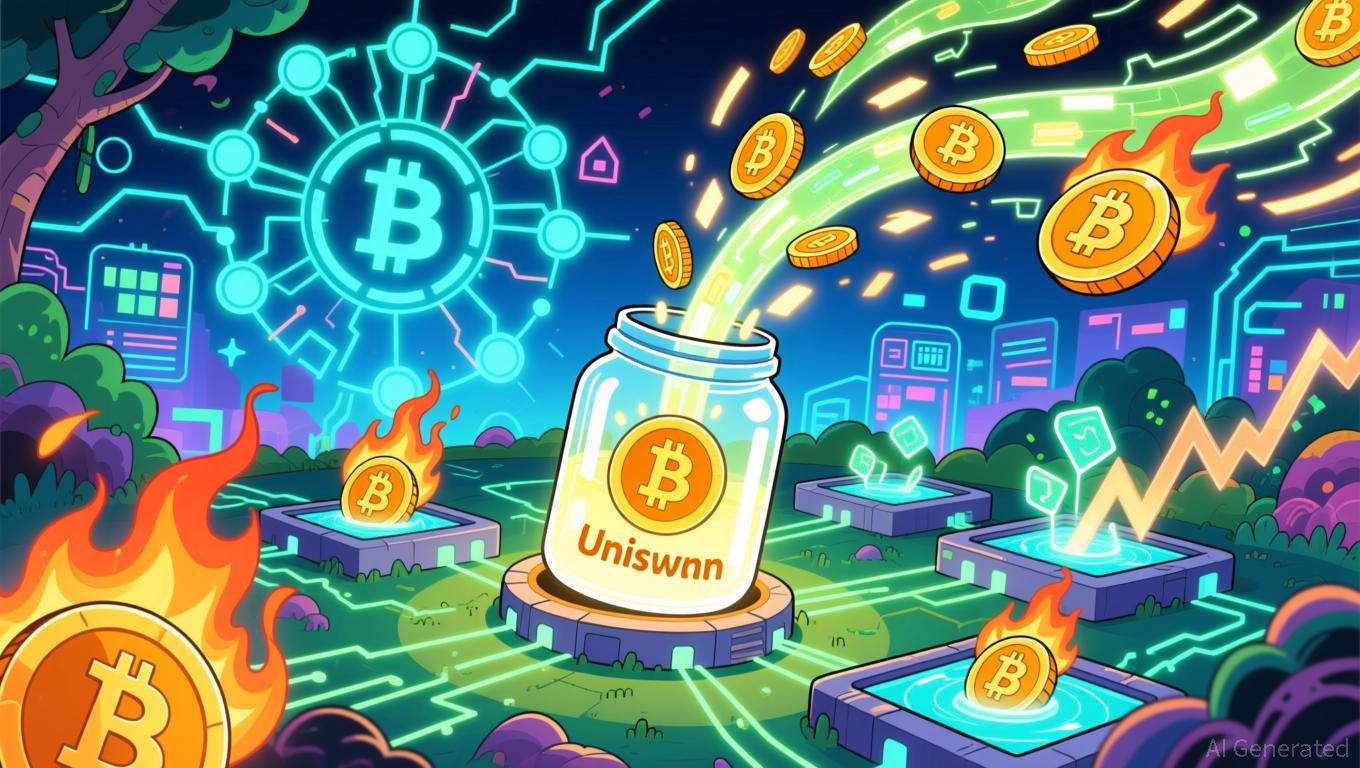Uniswap News Today: Addressing DeFi's Value Gap: Uniswap's Debated Fee Restructuring
- Uniswap's UNIfication proposal redirects trading fees to a "token jar," enabling UNI holders to burn tokens for assets, aiming to align protocol growth with token value. - The plan includes a 100M UNI retroactive burn (16% of supply) and Layer-2 integration to sustain supply reduction, addressing DeFi's historic disconnect between usage and token valuation. - Critics warn liquidity providers may lose earnings, while a UK whale's $10M short positions highlight market skepticism despite community debates o
Uniswap’s UNIfication Proposal: A New Era for DeFi Tokenomics
Uniswap has introduced the UNIfication proposal, a plan designed to directly connect the protocol’s trading fees with UNI token buybacks. This initiative has received strong early backing, suggesting a major transformation in the landscape of decentralized finance (DeFi) token economics. Although UNI’s market capitalization has dropped to $6.8 billion from its previous high of $21.7 billion, Uniswap’s monthly trading volume soared to $116.6 billion in 2025—almost three times higher than in 2023. This contrast between the protocol’s growth and the token’s declining value has fueled discussions about potential misalignments in DeFi governance. Supporters believe the proposal could address these issues by tying trading activity more closely to token demand.
The core of the UNIfication proposal is a fee switch mechanism that diverts a share of Uniswap v2 and v3 trading fees into a dedicated “token jar.” UNI holders would have the option to burn their tokens in exchange for assets from this jar, effectively reducing the token’s circulating supply and potentially increasing its value. Additionally, the proposal suggests a one-time burn of 100 million UNI tokens—representing 16% of the current supply—to compensate for fees missed during periods when the fee switch was inactive. By integrating revenue from Layer-2 solutions, this approach aims to create a sustainable model for reducing supply and rewarding long-term holders. However, some critics caution that liquidity providers (LPs) might see their earnings decrease as a result of the redirected fees.
Reactions from the market have been varied. A notable investor, known by the address 0xa31, has taken advantage of UNI’s price swings by shorting the token along with meme coins such as ASTER and MON. As of November 26, this investor had realized $6.23 million in profits from short positions, with an additional $4 million in unrealized gains. This activity reflects ongoing skepticism about UNI’s short-term prospects, even as the community debates the proposal’s long-term impact. Meanwhile, the UK’s fiscal policies have drawn comparisons to Uniswap’s strategy, particularly Chancellor Rachel Reeves’ budget proposal to increase international student fees in order to fund grants for domestic students—a move seen as another example of value redistribution.

Industry experts have largely welcomed the proposal’s potential to reshape DeFi economics. Crypto analyst Simon Dedic observed that the combination of the fee switch and retroactive token burns could prompt other DeFi projects to focus more on increasing token value, which may help restore investor confidence. He emphasized the importance of Uniswap’s initiative, suggesting it could bridge the longstanding gap between protocol performance and token valuation. Nonetheless, the proposal faces challenges. Its reliance on token burns differs from alternative models like veLocks, which reward long-term engagement through enhanced voting power. There are also concerns about the potential impact on liquidity providers and the possibility that less reputable pools could lose trading volume after the changes take effect.
As the DeFi sector considers the implications of the UNIfication proposal, its adoption could set a new standard for aligning token incentives with protocol success. By tackling structural inefficiencies and introducing features such as Protocol Fee Discount Auctions (PFDA) to capture MEV internally, Uniswap is positioning itself to remain competitive in the increasingly crowded decentralized exchange (DEX) market. The results of this initiative are likely to shape broader trends in the industry, especially as established financial players like Coinbase roll out their own ambitious DeFi offerings.
Disclaimer: The content of this article solely reflects the author's opinion and does not represent the platform in any capacity. This article is not intended to serve as a reference for making investment decisions.
You may also like
Infrastructure-Focused Economic Growth in Webster, NY
- Webster , NY leverages $9.8M FAST NY grant to upgrade infrastructure, targeting industrial growth via Xerox campus redevelopment and blight removal. - Xerox's 300-acre brownfield site transforms into a $650M industrial hub by 2025, creating 250 jobs at fairlife® dairy facility with enhanced utilities. - Blight removal at 600 Ridge Road and $1.8M road realignment projects unlock 300 acres for development, improving logistics and downtown connectivity. - WEDA and municipal coordination streamline land sale

BNB News Today: BNB Jumps 4%—Is This a Bullish Breakout or the Start of a Bearish Trend?
- BNB surged 4% on Nov 24, 2025, driven by a break above its 50-day SMA, signaling renewed buying pressure and bullish momentum. - Key technical levels at $860 (support) and $920 (20-day EMA) highlight potential for reversal or pullback, with volume/on-chain data critical for confirmation. - Market optimism stems from BNB Chain upgrades, DeFi growth, and macro factors like BNP Paribas' $1.15B buyback, indirectly boosting investor sentiment. - Future gains depend on ecosystem scalability, cross-chain adopti

Tech Issues Compel MegaETH to Return $500M After $1B Fundraising Mishap
- MegaETH refunds $500M after technical errors in KYC system and multisig transaction caused its $1B fundraising to exceed limits. - Project admits "sloppy execution" led to premature cap increase and user exploitation during pre-deposit phase. - Crypto community reacts with criticism over preventable mistakes, while praising transparency in disclosing failures. - Parallel Berachain case highlights industry risks through unusual $25M refund clause with unverified compliance requirements. - Incidents unders

Deciphering How Municipal Infrastructure Grants Influence Real Estate Growth and Investment Prospects
- New York's FAST NY program allocated $283M to transform 7,700 acres of industrial land into "shovel-ready" sites for high-tech manufacturing and semiconductors . - Infrastructure upgrades like water/sewer systems directly increased land values by 20% in industrial zones, attracting anchor tenants like Chobani and Micron . - 2025 tax reforms (100% bonus depreciation) amplified private investment, with Q3 2025 real estate deals hitting $310B as manufacturers targeted upgraded sites. - Critics highlight rur
